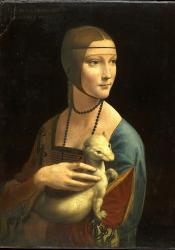Lady with an Ermine
One of the most distinct changes art experienced in the renaissance was an evolution in the purpose it served. During the medieval period, the purpose of art was to educate viewers about religion as well as serving as a form of worship. The population during this time was largely illiterate and had very limited access to religious texts, which meant that a visual representation enabled the viewers to directly connect with and worship their religious icons. Artwork in the renaissance, on the other hand, was more concerned with the aesthetics rather than the religious symbolism that it represented. This is due in part to the rise of humanism which led to an emphasis on the secular ideals of Greek and Roman thought. This painting, Lady with an Ermine by Leonardo da Vinci, is a perfect example of this. The purpose of this painting is entirely secular; it is celebrating the talent of the artist in portraying the beauty and purity of a noblewoman. Such a show of status and wealth would have been considered hubris during the middle ages but in reality, marked the beginning of a new era in art history.
Sources
Stokstad, Marilyn, and Michael W. Cothren. Art History. Upper Saddle River, NJ:
Pearson/Prentice Hall, 2011. Print.
Wikipedia, the free encyclopedia. “Lady with an Ermine.” Wikipedia, Wikimedia Foundation, Inc.,
6 Mar. 2018, en.wikipedia.org/wiki/Lady_with_an_Ermine.
Image Retrieved from Wikimedia Commons, fair use

